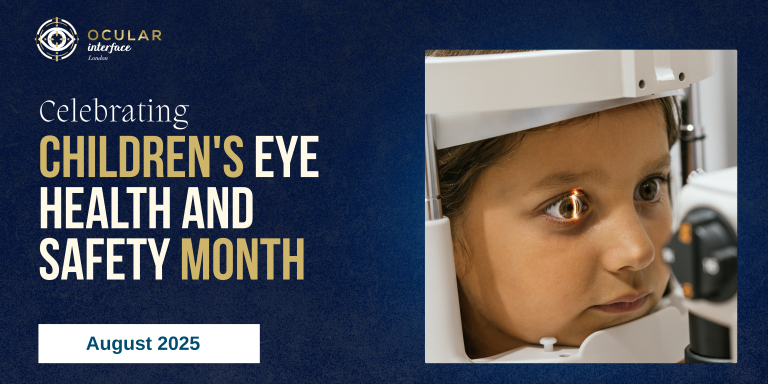Varun Ranganathan, MCOptom
Clinical Optometrist
An OCULAR Interface Exclusive
Synopsis
This blog explores how artificial intelligence is transforming the landscape of ophthalmic surgery—from preoperative planning to postoperative care. This blog highlights how AI-driven imaging analysis, predictive modeling, and personalised data insights are helping surgeons make more informed decisions, minimise complications, and improve patient outcomes in procedures such as cataract removal, LASIK, and retinal surgery.
Introduction
Advancements in artificial intelligence (AI) are reshaping the field of ophthalmology, particularly in the realm of surgery. From preoperative planning to postoperative monitoring, AI-driven tools are increasingly playing a pivotal role in improving accuracy, efficiency, and outcomes in eye surgeries. Cataract extraction, retinal procedures, corneal transplants, and refractive surgeries like LASIK are among those most positively impacted.
Preoperative Precision: Better Planning, Better Outcomes
Successful eye surgery begins well before the operating theatre. Accurate diagnosis, precise measurement, and risk stratification are all critical to ensuring optimal outcomes. AI algorithms are now capable of analysing high-resolution images from OCT (optical coherence tomography), fundus photography, and biometry data to assist clinicians in diagnosing conditions and planning interventions with remarkable accuracy. 1,2
For example, AI-powered biometry platforms can refine intraocular lens (IOL) power calculations for cataract surgery, factoring in subtle anatomical variations often missed by conventional formulas. 3 This leads to improved refractive outcomes and higher patient satisfaction.
Moreover, machine learning models can predict surgical complications in high-risk patients by analysing clinical history, imaging data, and demographics. 4 This proactive approach enables better surgical planning, tailored patient counselling, and informed consent.
Intraoperative Support: Real-Time Assistance
AI is also entering the operating room. Image-guided systems with AI integration help ophthalmic surgeons maintain orientation and precision during delicate procedures. Real-time tracking of surgical instruments, eye movement, and tissue response provides dynamic feedback that enhances safety and reduces the margin for error. 5
In retinal surgery, for instance, AI-powered platforms assist in identifying landmarks and retinal layers, guiding membrane peeling or laser treatment with increased accuracy. Some robotic systems, still in early stages, use AI to automate aspects of surgery under the supervision of the surgeon—promising enhanced control in microsurgical tasks. 6
Postoperative Monitoring and Outcome Prediction
Post-surgical recovery can be just as crucial as the procedure itself. AI-driven mobile apps and telemedicine platforms allow patients to self-monitor symptoms such as visual acuity or discomfort, alerting clinicians if abnormal patterns emerge. 7 This is particularly beneficial in remote or resource-limited areas, where follow-up care may be inconsistent.
Additionally, AI can track outcomes across large patient datasets to detect patterns of success or complications. These insights feed back into preoperative planning tools, creating a continuous loop of learning and improvement—a concept known as the “AI feedback cycle”. 8
Ethics, Safety, and the Human Touch
Despite the promise of AI, integration into surgical workflows must be approached responsibly. Datasets used to train AI models should be diverse and inclusive, representing different ethnicities, ages, and comorbidities to avoid algorithmic bias. 9
Importantly, AI should augment—not replace—the clinical expertise of ophthalmic surgeons. Human oversight ensures contextual understanding, empathy, and nuanced decision-making that AI alone cannot provide. Clear regulatory guidelines and robust validation are also essential to ensure patient safety and trust. 10
Conclusion
The use of AI in eye surgery marks a significant step forward in delivering safer, more predictable, and patient-centred care. By improving precision at every stage—from diagnosis to postoperative monitoring—AI is helping clinicians enhance surgical outcomes and expand access to high-quality vision care. As we continue to harness its potential, the future of ophthalmic surgery looks not only brighter—but sharper and smarter as well.
At OCULAR Interface, we champion the ethical and responsible use of AI in all aspects of eye care, working towards a future where innovation and human expertise go hand in hand.
References
- Ting, D. S. W., Pasquale, L. R., Peng, L. et al. (2019). Artificial intelligence and deep learning in ophthalmology. British Journal of Ophthalmology, 103(2), 167–175. https://doi.org/10.1136/bjophthalmol-2018-313173
- Schmidt-Erfurth, U., Sadeghipour, A., Gerendas, B. S. et al. (2018). Artificial intelligence in retina. Progress in Retinal and Eye Research, 67, 1–29. https://doi.org/10.1016/j.preteyeres.2018.07.004
- Li, T., Wang, T., & Zhang, X. (2020). AI-based IOL power calculation for cataract surgery. Clinical and Experimental Ophthalmology, 48(8), 1044–1050.
- Ghosh, R., Dey, P., & Das, A. V. (2022). Predicting complications in cataract surgery using machine learning. Eye, 36(3), 491–497.
- Asaoka, R., Murata, H., Fujino, Y. et al. (2021). Real-time AI assistance in surgical navigation systems. Graefe’s Archive for Clinical and Experimental Ophthalmology, 259, 951–960.
- Nassisi, M., Mariotti, C., Caporossi, T. et al. (2020). Robotic-assisted retinal surgery: A clinical perspective. Retina, 40(6), 1111–1117.
- Rokicki, W., Rokicki, M., & Wojciechowski, M. (2021). Postoperative patient monitoring via mobile AI apps. Acta Ophthalmologica, 99(4), e638–e643.
- Zhang, Z., Muehlematter, U. J., & Donati, S. (2023). Continuous improvement in AI-assisted ophthalmic surgery. Ophthalmology Science, 3(1), 100123.
- Obermeyer, Z., Powers, B., Vogeli, C., & Mullainathan, S. (2019). Dissecting racial bias in health algorithms. Science, 366(6464), 447–453. https://doi.org/10.1126/science.aax2342
- UK Medicines and Healthcare products Regulatory Agency (MHRA). (2022). Software and AI as a Medical Device Change Programme. https://www.gov.uk/government/publications/software-and-ai-as-a-medical-device-change-programme










